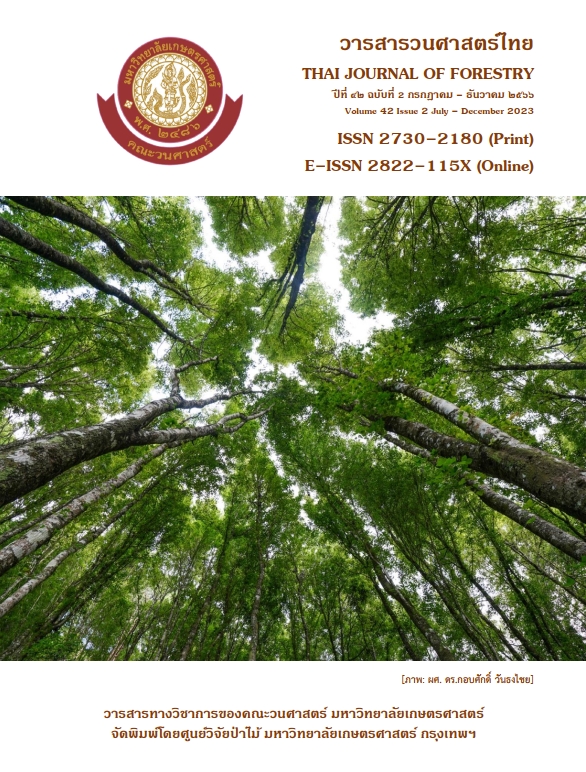ลักษณะการทำลายของหนอนไม้ไผ่ (Omphisa fuscidentalis) ในไผ่หวานอ่างขาง (Dendrocalamus latiflorus) ณ สถานีเกษตรหลวงปางดะ จังหวัดเชียงใหม่
Main Article Content
บทคัดย่อ
การศึกษาลักษณะการทำลายของหนอนไม้ไผ่ (Omphisa fuscidentalis) ที่พบในไผ่หวานอ่างขาง (Dendrocalamus latiflorus) ได้ศึกษาในพื้นที่สถานีเกษตรหลวงปางดะ อำเภอสะเมิง จังหวัดเชียงใหม่ ดำเนินการศึกษาระหว่างเดือนกันยายน พ.ศ. 2563 – เดือนกุมภาพันธ์ พ.ศ. 2564 โดยศึกษาปริมาณหนอนไม้ไผ่ ลักษณะการทำลายภายนอกและภายในที่ลำไผ่ได้รับความเสียหาย เพื่อใช้เป็นข้อมูลพื้นฐานและนำไปศึกษาชนิดไผ่ที่มีความเหมาะสมในการเลี้ยงหนอนไม้ไผ่ จากการศึกษาพบหนอนไม้ไผ่เฉลี่ย 190 ตัวต่อลำ จำนวนปล้องที่ถูกทำลายเฉลี่ย 14 ปล้องต่อลำ การทำลายของหนอนไม้ไผ่ไม่ส่งผลกระทบต่อขนาดความโตไผ่ แต่บริเวณปล้องการทำลายที่ 9–13 เฉลี่ย 5 ปล้องต่อลำ พบการทำลายมากส่งผลให้ปล้องไผ่มีความยาวปล้องสั้นลง คิดเป็น 48.8% ของปล้องก่อนปล้องถูกทำลาย และพบเนื้อไม้ทะลุเป็นร่องร่วมกับบริเวณที่มีความยาวปล้องสั้น ซึ่งเป็นผลมาจากการกินเยื่อไผ่และเนื้อไผ่ของตัวหนอนในปริมาณมาก โดยพบว่ามีร้อยละการกินเยื่อไผ่และเนื้อไผ่มากที่สุดประมาณ 70% แต่ปล้องเหนือปล้องถูกทำลายยังสามารถเติบโตต่อไปได้ ทั้งนี้ จากการศึกษาพบจำนวนหนอนไม้ไผ่มากที่สุด 484 ตัวต่อลำ จึงสรุปได้ว่า ไผ่หวานอ่างขางสามารถพบปริมาณและน้ำหนักหนอนไม้ไผ่ต่อลำ มากกว่าปกติ และนำไปเป็นแนวทางในการศึกษาด้านการเพิ่มผลผลิตหนอนไม้ไผ่ต่อลำต่อไป
Downloads
Article Details

อนุญาตภายใต้เงื่อนไข Creative Commons Attribution-NonCommercial-NoDerivatives 4.0 International License.
ข้าพเจ้าและผู้เขียนร่วม (ถ้ามี) ขอรับรองว่า ต้นฉบับที่เสนอมานี้ยังไม่เคยได้รับการตีพิมพ์และไม่ได้อยู่ในระหว่างกระบวนการพิจารณาตีพิมพ์ลงในวารสารหรือสิ่งตีพิมพ์อื่นใด ข้าพเจ้าและผู้เขียนร่วม (ถ้ามี) ยอมรับหลักเกณฑ์และเงื่อนไขการพิจารณาต้นฉบับ ทั้งยินยอมให้กองบรรณาธิการมีสิทธิ์พิจารณาและตรวจแก้ต้นฉบับได้ตามที่เห็นสมควร พร้อมนี้ขอมอบลิขสิทธิ์ผลงานที่ได้รับการตีพิมพ์ให้แก่วารสารวนศาสตร์ คณะวนศาสตร์ มหาวิทยาลัยเกษตรศาสตร์ กรณีมีการฟ้องร้องเรื่องการละเมิดลิขสิทธิ์เกี่ยวกับภาพ กราฟ ข้อความส่วนใดส่วนหนึ่ง หรือ ข้อคิดเห็นที่ปรากฏในผลงาน ให้เป็นความรับผิดชอบของข้าพเจ้าและผู้เขียนร่วม (ถ้ามี) แต่เพียงฝ่ายเดียว และหากข้าพเจ้าและผู้เขียนร่วม (ถ้ามี) ประสงค์ถอนบทความในระหว่างกระบวนการพิจารณาของทางวารสาร ข้าพเจ้าและผู้เขียนร่วม (ถ้ามี) ยินดีรับผิดชอบค่าใช้จ่ายทั้งหมดที่เกิดขึ้นในกระบวนการพิจารณาบทความนั้น”
เอกสารอ้างอิง
Choldumrongkul, A. 1991. Shoot damages in Dendrocalamus strictus Nees and Gigantochloa hasskarliana Back. ex. K. Heyne caused by Cyrtotrachelus sp. and dried out disease. Thai Journal of Forestry, 10: 115–119. (in Thai)
Kamolngam, S. 2015. Involvement of Ecdysone Inducible Gene in Larval Diapause Termination in Bamboo Borer (Omphisa fuscidentalis Hampson). M.S. Thesis, Chiang Mai University, Chiang Mai, Thailand.
Kayikananta, L. 1994. Biological and ecological study on bamboo caterpillar (Omphisa sp.). In: Proceedings of the Forestry Conference. RFD, Surat Thani, Thailand, pp.159–171. (in Thai)
Kayikananta, L. 1997, Biological Study and Rearing Techniques on Bamboo Caterpillar, Omphisa fuscidentalis Hampson. Royal Forest Department, Bangkok, Thailand.
Kayikananta, L. 2000. Biological study and rearing techniques on bamboo caterpillar, Omphisa fuscidentalis Hampson. In: Proceedings of the 38th Kasetsart University Annual Conference. Kasetsart University, Bangkok, Thailand. pp. 450–459. (in Thai)
Jun, M. 2017. Edible Insect of The World. CRC Press, Boca Raton, Florida, USA.
Phungchik, T. 2008. Amazing bamboo plant. Journal of Forest Management, 2(4): 58–68. (in Thai)
Phungchik, T., Ruensuk, P., Jirakiattikul, Y. 2015. Study on growth of four bamboo varieties. Thai Journal of Science and Technology, 4(3): 302–309. (in Thai)
Phungchik, T., Promproh, K., Harakotr, B. 2016. Effect of chemical fertilizer on growth of bamboo (Dendrocalamus sericeus) seedling. Thai Journal of Science and Technology, 5: 246–255. (in Thai)
Protected Area Rehabilitation and Development Office. 2019. Bamboo Inventory in Thailand. https://shorturl.asia/r3Iub, 28 October 2019.
Singhatripop, T. 2012. The miracle of Bamboo Borer Life, 1st ed. Nopburee Press, Chiang Mai, Thailand. (in Thai)
Sompoh, B., Ruantip, A., Chadthasing, B., Wongsrikaew, C., Wongsrikaew, P., Theoprasong, T., Aewsakulthong, W. 2015. The Properties and Anatomy of Some Bamboo Species. https://shorturl.asia/wiu7F, 4 September 2019.
Suksard, S., Wiwatwitaya, D. 1998. Marketing of bamboo caterpillar (Omphisa sp.). Thai Journal of Forestry, 17: 36–42. (in Thai)
Sungkaew, S., Teerawatananon, A., Jindawong, K., Thaiutsa, B. 2007. Diversity of highland bamboos. Thai Journal of Forestry, 26: 1–11. (in Thai)
Sungkaew, S., Teerawatananon, A., Jindawong, K. 2011. Bamboo of Thailand. Amarin Printing & Publishing Public Co., Ltd., Bangkok, Thailand. (in Thai)
Wiwatwitaya, D. 1992. Biology of Bamboo caterpillar. In: Proceeding of the Forestry Conference 1992. RFD, Bangkok, Thailand, pp. 99–110. (in Thai)
Wiwatwitaya, D., Na Lampang, S. 1992. Bamboo caterpillar (Lepidoptera: Pyralidae). Thai Journal of Forestry, 11: 16–21. (in Thai)


